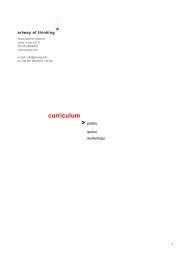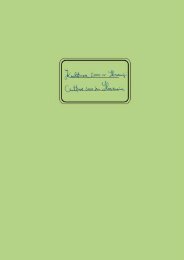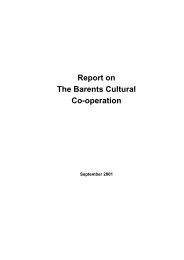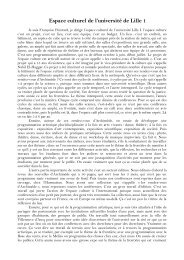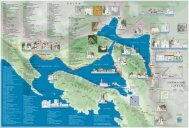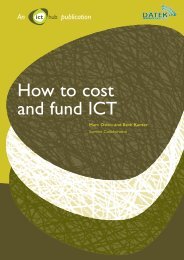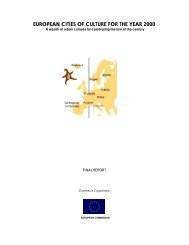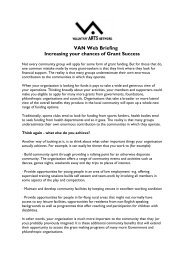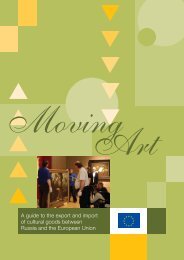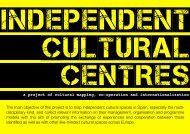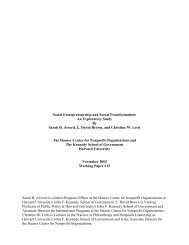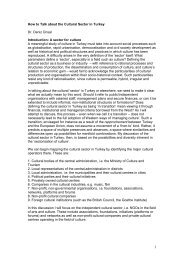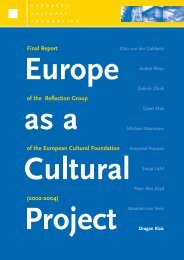Sustainability: a new frontier for the arts and cultures - Cultura21
Sustainability: a new frontier for the arts and cultures - Cultura21
Sustainability: a new frontier for the arts and cultures - Cultura21
You also want an ePaper? Increase the reach of your titles
YUMPU automatically turns print PDFs into web optimized ePapers that Google loves.
higher education <strong>for</strong> sustainability<br />
Sacha Kagan / Volker Kirchberg (eds.)<br />
<strong>Sustainability</strong>:<br />
a <strong>new</strong> <strong>frontier</strong> <strong>for</strong><br />
<strong>the</strong> <strong>arts</strong> <strong>and</strong> <strong>cultures</strong>
Sacha Kagan / Volker Kirchberg (eds.)<br />
<strong>Sustainability</strong>:<br />
a <strong>new</strong> <strong>frontier</strong> <strong>for</strong> <strong>the</strong> <strong>arts</strong> <strong>and</strong> <strong>cultures</strong>
Volume 3 of <strong>the</strong> series<br />
“Higher Education <strong>for</strong> <strong>Sustainability</strong>“<br />
Edited by Gerd Michelsen<br />
The book series “Higher Education <strong>for</strong> <strong>Sustainability</strong>“ provides in<strong>for</strong>mation<br />
<strong>and</strong> experiences on <strong>the</strong> question of how sustainable development may be<br />
applied as a guiding principle <strong>for</strong> university education, <strong>and</strong> how it may be<br />
implemented in sustainability-related research activities. A variety of different<br />
political, methodological, <strong>and</strong> didactical approaches are intended to<br />
<strong>for</strong>m an intricate mosaic of ongoing activities from around <strong>the</strong> world in<br />
<strong>the</strong> field of higher education. The series aims at stimulating international<br />
cooperation <strong>and</strong> intercultural dialogue on higher education <strong>for</strong> sustainable<br />
development. It is edited by Prof. Dr. Gerd Michelsen, holder of <strong>the</strong> UNESCO<br />
Chair ‘Higher Education <strong>for</strong> Sustainable Development’, based at <strong>the</strong> Leuphana<br />
University of Lüneburg (www.leuphana.de/infu/chair).
Sacha Kagan / Volker Kirchberg (eds.)<br />
<strong>Sustainability</strong>:<br />
a <strong>new</strong> <strong>frontier</strong> <strong>for</strong> <strong>the</strong> <strong>arts</strong> <strong>and</strong> <strong>cultures</strong>
Wi(e)der die Armut?<br />
Bibliographic in<strong>for</strong>mation published by <strong>the</strong> Deutsche Nationalbiblio<strong>the</strong>k<br />
The Deutsche Nationalbiblio<strong>the</strong>k lists this publication in <strong>the</strong> Deutsche Nationalbibliografie;<br />
detailed bibliographic data are available in <strong>the</strong> Internet at<br />
http://dnb.d-nb.de.<br />
The image on <strong>the</strong> front page is “The Flower of <strong>Sustainability</strong>“, an artistic<br />
depiction by <strong>the</strong> artist Insa Winkler who explains this image in her article<br />
in this book.<br />
© 2008 VAS – Verlag für Akademische Schriften<br />
Alle Rechte vorbehalten.<br />
Herstellung: VAS, Wiel<strong>and</strong>straße 10, 60318 Frankfurt am Main<br />
Vertrieb: Südost Verlags Service GmbH, Am Steinfeld 4,<br />
94065 Waldkirchen<br />
Printed in Germany · ISBN 978-3-88864-440-5<br />
4
Abkürzungsverzeichnis<br />
Contents<br />
Gün<strong>the</strong>r Bachmann<br />
Gatekeeper: a <strong>for</strong>eword .............................................................................. 8<br />
Introduction<br />
Sacha Kagan<br />
<strong>Sustainability</strong> as a New Frontier <strong>for</strong> <strong>the</strong> Arts <strong>and</strong> Cultures .................. 14<br />
Chapter 1: Cultures of <strong>Sustainability</strong><br />
Davide Brocchi<br />
The Cultural Dimension of <strong>Sustainability</strong> .............................................. 26<br />
Oleg Koefoed<br />
Zones of Sustension: an exploration of eventality, culturality,<br />
<strong>and</strong> collective intuition in life <strong>and</strong> work ................................................. 59<br />
Volker Kirchberg<br />
Angst <strong>and</strong> Unsustainability in Postmodern Times ................................ 93<br />
Chapter 2: The Reflexive Artist <strong>and</strong> <strong>the</strong> Ethics of <strong>Sustainability</strong><br />
Hans Dieleman<br />
<strong>Sustainability</strong>, Art <strong>and</strong> Reflexivity: why artists <strong>and</strong> designers<br />
may become key change agents in sustainability ................................ 108<br />
Sacha Kagan<br />
Art Effectuating Social Change: double entrepreneurship<br />
in conventions ......................................................................................... 147<br />
David Haley<br />
The Limits of <strong>Sustainability</strong>: <strong>the</strong> art of ecology ................................... 194<br />
5
Wi(e)der die Armut?<br />
Chapter 3: Discourses, Practices <strong>and</strong> Search Processes in <strong>the</strong> Arts<br />
Felicia Herrschaft<br />
Reflections on Vulnerability: aspects of sustainability of<br />
art in post-war <strong>and</strong> conflict societies; <strong>the</strong> examples of Kosovo<br />
<strong>and</strong> Afghanistan ...................................................................................... 210<br />
Julien Knebusch<br />
Art <strong>and</strong> Climate (Change) Perception: outline of<br />
a phenomenology of climate ................................................................. 242<br />
Chapter 4: Voices from <strong>the</strong> Field<br />
Aviva Rahmani<br />
The Butterfly Effect of Hummingbirds: environmental triage:<br />
disturbance <strong>the</strong>ory, triggerpoints, <strong>and</strong> virtual<br />
analogs <strong>for</strong> physical sites ........................................................................ 264<br />
Jan Jordaan<br />
Art, Advocacy <strong>and</strong> Social Development: designing <strong>and</strong><br />
implementing art-based human rights advocacy campaigns<br />
at <strong>the</strong> organisation Art <strong>for</strong> Humanity ................................................... 290<br />
Insa Winkler<br />
Chances <strong>and</strong> Limits of Art <strong>and</strong> <strong>Sustainability</strong> ..................................... 320<br />
Chapter 5: Unsustainable Art Worlds or Unsustainable Uses<br />
of <strong>the</strong> Arts?<br />
Caterina Pizanias<br />
Manifesta 2006: when art met politics .................................................. 324<br />
Arild Bergh<br />
Everlasting Love: <strong>the</strong> sustainability of top-down versus<br />
bottom-up approaches to music <strong>and</strong> conflict trans<strong>for</strong>mation............ 351<br />
Kubilay Akman<br />
Artist’s Ego-Trip: framing <strong>the</strong> self-destructive dimensions<br />
of contemporary <strong>arts</strong> through Alem Korkut’s work ............................ 383<br />
6
Abkürzungsverzeichnis<br />
Chapter 6: Cultural Heritage, Creative Cities <strong>and</strong> Development<br />
Pier Luigi Sacco, Guido Ferilli <strong>and</strong> Sabrina Pedrini<br />
System-Wide Cultural Districts: an introduction from<br />
<strong>the</strong> Italian viewpoint ............................................................................... 400<br />
Annie Tubadji<br />
Sustainable Utilization of Cultural Heritage Resources <strong>for</strong><br />
Socio-Economic Development Purposes: what has to be done<br />
by institutions <strong>and</strong> organizations? ........................................................ 461<br />
Chapter 7: Fashion <strong>and</strong> Ethics (or how does sustainability<br />
enter <strong>the</strong> creative industries?)<br />
Laura Verdi<br />
From Art & Fashion to Homo Civicus .................................................. 498<br />
Emanuela Mora<br />
The Symbolic <strong>and</strong> Material Space of Fair Fashion .............................. 529<br />
Postface<br />
Sacha Kagan <strong>and</strong> Hans Dieleman<br />
Seven Points <strong>for</strong> an Agenda: research <strong>and</strong> action<br />
on <strong>cultures</strong> <strong>and</strong> <strong>arts</strong> <strong>for</strong> sustainability ................................................... 560<br />
About <strong>the</strong> Authors ................................................................................ 566<br />
7
<strong>Sustainability</strong>: a <strong>new</strong> <strong>frontier</strong> <strong>for</strong> <strong>the</strong> <strong>arts</strong> <strong>and</strong> <strong>cultures</strong><br />
Gün<strong>the</strong>r Bachmann<br />
“Gatekeeper: a <strong>for</strong>eword“<br />
Scarcity changes everything. With <strong>the</strong> limited availability of water <strong>and</strong> soil<br />
becoming more <strong>and</strong> more relevant <strong>for</strong> food supply <strong>and</strong> economic development,<br />
<strong>the</strong> wheat <strong>and</strong> corn prices recently jumped to a 10 years high. Oiljunky-economies<br />
increasing <strong>the</strong> oil consumption even in peak-oil times<br />
link-up <strong>the</strong> oil <strong>and</strong> food prices, with all <strong>the</strong> humiliating <strong>and</strong> dramatic consequences<br />
this link means to people <strong>and</strong> <strong>the</strong> environment. There<strong>for</strong>e, “future“<br />
needs to be spelled as carbon neutrality <strong>and</strong> as sustainability. However, our<br />
society as a whole – despite its economy of <strong>the</strong> plenty compared to global<br />
st<strong>and</strong>ards – does not yet seem to accept <strong>the</strong> signs on <strong>the</strong> wall. What avantgarde<br />
do we wait <strong>for</strong> to read out <strong>the</strong> signs <strong>and</strong> interpret <strong>the</strong>m into a zeitgeist?<br />
Halting <strong>the</strong> destruction of <strong>the</strong> earth’s environment, helping people to<br />
free <strong>the</strong>mselves from <strong>the</strong> shackles of poverty, <strong>and</strong> leaving opportunities<br />
instead of debts to coming generations, all of this involves nothing short<br />
of a fundamental change in our way of working <strong>and</strong> consuming. All this is<br />
about ethics <strong>and</strong> culture, as it is about technologies, governance, participation<br />
<strong>and</strong> policies. If <strong>the</strong>re is one key issue that will help to get this<br />
transition done, science <strong>and</strong> education would be it. If <strong>the</strong>re is one key issue<br />
that will help people to emotionally underst<strong>and</strong> <strong>the</strong> ups <strong>and</strong> downs of this<br />
transition, art would be it. There is no “ei<strong>the</strong>r, or“. There is no sense in<br />
prioritizing of “hard measures“ such as technologies <strong>and</strong> “soft issues“ such<br />
as ethics. Down <strong>the</strong> road we will have to address all <strong>the</strong>se issues.<br />
In order to facilitate <strong>the</strong> underst<strong>and</strong>ing of what is at stake globally <strong>the</strong><br />
value of <strong>the</strong> <strong>arts</strong> <strong>and</strong> culture is a tricky thing. Theoretically, everyone talks<br />
about <strong>the</strong> importance of <strong>the</strong> <strong>arts</strong> <strong>for</strong> a more sustainable thinking. Practically,<br />
it is underused <strong>and</strong> underrated, maybe even not well understood <strong>and</strong>, worse,<br />
not well conceptualized by artists <strong>the</strong>mselves. It is not at all acknowledged<br />
in <strong>the</strong> art’s business which is different from recent development in <strong>the</strong><br />
business community in general. In <strong>the</strong> chemical industry, electronics or<br />
producing sectors as well as in <strong>the</strong> financial sector some leading enterprises<br />
are biting into <strong>the</strong> issues of sustainability management. Cleavage <strong>and</strong><br />
antagonism are food <strong>for</strong> thought, at least <strong>the</strong>re is a certain potential to do<br />
so.<br />
8
Gün<strong>the</strong>r Bachmann: Gatekeeper: a <strong>for</strong>eword<br />
Only golddusting?<br />
In <strong>the</strong> German political discourse, we find <strong>the</strong> term Nachhaltigkeit currently<br />
used quite inflationary, with some definitely misleading <strong>and</strong> superficial<br />
use of <strong>the</strong> term. In a certain way <strong>the</strong> term sustainability is used as semantic<br />
gold dust. But <strong>the</strong> good <strong>new</strong>s is that, once <strong>the</strong> term surfaces at all, <strong>the</strong>re is<br />
a good chance that this opens <strong>the</strong> debate about <strong>the</strong> basic sense of <strong>the</strong><br />
sustainability challenge. This is good because it translates into an argument.<br />
And argument is what we need when it comes to sustainability challenging<br />
vested interests. There are more <strong>and</strong> more people who can tell <strong>the</strong> difference.<br />
The point <strong>for</strong> communicating sustainability is to link ideas <strong>and</strong> actions<br />
towards energy transition, next urbanism, <strong>and</strong> organic food production<br />
with <strong>the</strong> underst<strong>and</strong>ing of sustainability as a cultural <strong>and</strong> <strong>arts</strong> project.<br />
Culture helps to detect <strong>and</strong> discard semantic gold dust. For <strong>arts</strong> <strong>and</strong><br />
culture policies, <strong>the</strong> same task holds true as <strong>for</strong> o<strong>the</strong>r areas of society, be it<br />
<strong>the</strong> business community or <strong>the</strong> Government strategies: Keeping a critical<br />
eye on what people actually mean when <strong>the</strong>y use <strong>the</strong> word “sustainability“.<br />
As we see <strong>the</strong> concept branching out <strong>and</strong> webbing into society (which is<br />
good) we experience some examples of a misuse of <strong>the</strong> term. I call it a misuse<br />
when sustainability is used as <strong>the</strong> fashionable keyword of <strong>the</strong> season, in <strong>the</strong><br />
sense of mere long durability, or as a replacement of <strong>the</strong> term ecology with<br />
no added social, cultural or economic value.<br />
Introducing <strong>new</strong> ways<br />
As an adviser to <strong>the</strong> German government, <strong>the</strong> German Council <strong>for</strong> Sustainable<br />
Development has created some sorts of <strong>new</strong> approaches to link<br />
culture <strong>and</strong> sustainability. The Council has also encouraged o<strong>the</strong>rs to experiment<br />
with <strong>new</strong> pathways to communicate sustainability. Organizing strategy<br />
sessions <strong>and</strong> workshops, <strong>and</strong> integrating a wide range of cultural projects<br />
into its own events has resulted in pieces of design work <strong>and</strong> literature, in<br />
movie pictures <strong>and</strong> commercials advocating sustainability. The photo competition<br />
“Facing <strong>Sustainability</strong>“, <strong>the</strong> grassroots best practice competition “24<br />
Hours <strong>for</strong> Tomorrow’s World“, <strong>and</strong> an exhibition of artists active in sustainability<br />
projects, “passageN“, show that <strong>the</strong> somewhat unwieldy <strong>and</strong> awkward term<br />
of sustainability can reach out to <strong>the</strong> people, as a cultural project.<br />
9
<strong>Sustainability</strong>: a <strong>new</strong> <strong>frontier</strong> <strong>for</strong> <strong>the</strong> <strong>arts</strong> <strong>and</strong> <strong>cultures</strong><br />
A lesson to be learnt from both engineers <strong>and</strong> artists as well: Do not stop<br />
asking questions. In this case: Are we successfully communicating? Are<br />
we up-linking art <strong>and</strong> sustainability in a creative way? Could we do better?<br />
Are we really addressing <strong>the</strong> zeitgeist? And if so, are we surfing on <strong>the</strong><br />
zeitgeist or are we drivers? There is no easy answer. I mistrust any quick<br />
<strong>and</strong> elegant answer anyway. I think we have to put <strong>the</strong>se questions <strong>for</strong>ward<br />
again <strong>and</strong> again. By putting toge<strong>the</strong>r <strong>the</strong> views of as many people as possible<br />
we will find some answers. And <strong>new</strong> questions as well – as <strong>the</strong> contributions<br />
to this book will underline.<br />
Challenging <strong>the</strong> zeitgeist<br />
Art <strong>and</strong> <strong>Sustainability</strong> is also about <strong>the</strong> underst<strong>and</strong>ing of art itself. All art is<br />
about <strong>the</strong> future of mankind. The well-known saying is true: All art is<br />
contemporary. And all contemporary art, in some way, conveys a vision <strong>for</strong><br />
<strong>the</strong> future. Be it Michelangelo, Brueghel’s Ikarus or Jackson Pollock’s work,<br />
pieces of art point visions of future out, sometimes hidden <strong>and</strong> reflected.<br />
In this underst<strong>and</strong>ing, artists are challenging <strong>the</strong> zeitgeist, <strong>and</strong> at <strong>the</strong> same<br />
time, contributing to its permanent re<strong>new</strong>al. Today, this general approach<br />
has to close up more clearly to cover <strong>the</strong> realm of wrongheaded global<br />
developments. Arts <strong>for</strong> sustainability means involving people <strong>and</strong> providing<br />
room <strong>for</strong> <strong>the</strong>m to rethink future. We have to allow <strong>for</strong> ordinary people to<br />
become part of <strong>the</strong> action whereas <strong>the</strong> action itself would be professionally<br />
facilitated.<br />
This is a <strong>new</strong> feature. It emerges from <strong>the</strong> concept of intergenerational<br />
justice that is amplifying (not replacing) equity concepts within <strong>the</strong> living<br />
generation in North <strong>and</strong> South. Intergenerational justice asks what legacy<br />
<strong>the</strong> current way of living brings along <strong>for</strong> our children <strong>and</strong> <strong>the</strong>ir offspring.<br />
We are now facing <strong>the</strong> probability to dramatically downgrade pretty much<br />
all of <strong>the</strong> living conditions on earth. Communicating sustainability is not <strong>for</strong><br />
wallpaper, <strong>and</strong> not <strong>for</strong> simplistic propag<strong>and</strong>a, nor <strong>for</strong> mere contemplation.<br />
Love <strong>and</strong> death, <strong>and</strong> all what is in between, are natural <strong>the</strong>mes of art. The<br />
sustainability update is about our yearning <strong>for</strong> a sustainable lifestyle, equity<br />
in “here <strong>and</strong> <strong>the</strong>re“ as well as “now <strong>and</strong> <strong>the</strong>n“, our knowledge about all <strong>the</strong><br />
lunacy in <strong>the</strong> world <strong>and</strong> <strong>the</strong> non sustainable way of production <strong>and</strong><br />
consumption<br />
10
Gün<strong>the</strong>r Bachmann: Gatekeeper: a <strong>for</strong>eword<br />
Challenging <strong>the</strong> zeitgeist means making it visible <strong>and</strong> accessible, <strong>and</strong><br />
showing <strong>the</strong> way out of <strong>the</strong> crisis, if possible. Normally, this can nei<strong>the</strong>r be<br />
done in a mirror-like way, nor as a mere description of <strong>the</strong> ‘gloom <strong>and</strong><br />
doom’ nor of <strong>the</strong> belleza of our life. Instead, <strong>the</strong> raison d’être of art <strong>and</strong><br />
sustainability is time beyond <strong>the</strong> generational view. Making <strong>the</strong> experience<br />
of time is one of <strong>the</strong> very basic features of life. But.<br />
But we have to try harder to make this a trend that has <strong>the</strong> power to<br />
provoke <strong>the</strong> predominant mainstream culture. Mainstream culture is event<br />
culture. It sees more people than ever visit art exhibitions <strong>and</strong> museums.<br />
However, most of <strong>the</strong>m are looking blank <strong>and</strong> awestruck. No one gets<br />
upset, basic questions are seldom asked. It is <strong>the</strong> event in which <strong>the</strong>y believe.<br />
The dictum “all art is contemporary“ seems <strong>for</strong>gotten <strong>and</strong> being replaced<br />
by “all art is event“. Shortsighted event culture seems to eat up all art.<br />
Is <strong>the</strong>re a way to link what Vanity Fair’s first ever green issue proclaimed<br />
as “Green Glamour“ to <strong>the</strong> ‘<strong>cultures</strong> of sustainability’ as shown in this book?<br />
It is essential that both <strong>the</strong>oretical <strong>and</strong> empirical studies show how discourses<br />
<strong>and</strong> practices in art worlds pick <strong>the</strong> culture of sustainability out as<br />
central issue or do not witness what is going on globally. In this sense,<br />
successful action needs to be close enough to <strong>the</strong> spirit of <strong>the</strong> times to be<br />
relevant, <strong>and</strong>, at <strong>the</strong> same time, far enough ahead of <strong>the</strong> times to offer<br />
change <strong>and</strong> to <strong>frontier</strong>-guard <strong>the</strong> way towards future.<br />
From I-need to We-can<br />
In <strong>the</strong> decades after World War II, <strong>the</strong> defining ethos was “I need“. The I-<br />
need-icon <strong>for</strong>med <strong>the</strong> basics of a civilized life: growing living st<strong>and</strong>ards,<br />
decent education, social insurance against ill health <strong>and</strong> economic hardship,<br />
improved housing conditions. Those needs still remain, <strong>and</strong> with <strong>the</strong><br />
growing social divide <strong>the</strong>y tend to be more severe than in <strong>the</strong> past years.<br />
They must be satisfied as a basic part of solidarity <strong>and</strong> citizenship. But <strong>the</strong><br />
age of necessity is no longer <strong>the</strong> one <strong>and</strong> only issue driving <strong>the</strong> futurebound<br />
ethics of our society. By <strong>the</strong> 1980s, <strong>the</strong> age of necessity had given<br />
way to an age of consumption. The I-need-icon was replaced by <strong>the</strong> icon<br />
of “I want“ flanked by short-sighted event <strong>cultures</strong> <strong>and</strong> an economy that<br />
heats up <strong>the</strong> atmosphere. This is still predominant.<br />
11
<strong>Sustainability</strong>: a <strong>new</strong> <strong>frontier</strong> <strong>for</strong> <strong>the</strong> <strong>arts</strong> <strong>and</strong> <strong>cultures</strong><br />
Now, we need to drive <strong>for</strong>ward a <strong>new</strong> spirit. Some call it <strong>the</strong> “I can“<br />
philosophy. It focuses on a desire <strong>for</strong> people to not just have access to<br />
material goods, but greater power, control <strong>and</strong> choice over all aspects of<br />
<strong>the</strong>ir life <strong>and</strong> <strong>the</strong> life options of <strong>the</strong>ir offspring. It addresses <strong>the</strong> jobs <strong>the</strong>y<br />
do, <strong>the</strong> relationships <strong>the</strong>y enter, <strong>the</strong> services <strong>the</strong>y use, <strong>the</strong> products <strong>the</strong>y<br />
buy, what food <strong>the</strong>y eat <strong>and</strong> how <strong>the</strong>y relate to o<strong>the</strong>r people. To all this <strong>the</strong><br />
demographic change in our society adds additional features of transition:<br />
<strong>the</strong> decrease of overall population figures, with people getting older <strong>and</strong><br />
becoming more active, with fragmented families <strong>and</strong> <strong>new</strong> mobility needs,<br />
with <strong>new</strong> dem<strong>and</strong>s <strong>for</strong> life-long learning <strong>and</strong> <strong>for</strong> adequate housing <strong>for</strong> <strong>the</strong><br />
silver generation.<br />
The cutting edge here is culture. A more skilled population with access<br />
to technology can enable more <strong>and</strong> more people to become cultural creatives.<br />
They will come up with <strong>the</strong>ir own products <strong>and</strong> services – from blogs, films,<br />
music <strong>and</strong> games, right through to producing <strong>the</strong>ir own energy <strong>and</strong> designing<br />
<strong>the</strong>ir own social partnership schemes. The tools of distribution are open to<br />
all of us. Culture is distribution. In this sense, ‘I can’ means ‘I can connect’.<br />
From this step it is not far to <strong>the</strong> next one: From “I can“ to “we can“.<br />
This is explicitely true in <strong>the</strong> fight against climate change. Sure, individual<br />
action over lightbulbs or transport seems to make no difference contrasted<br />
with <strong>the</strong> <strong>new</strong> coal fired power station being built weekly in China.<br />
But this is only true at <strong>the</strong> first glance. The fundamental answer is to<br />
aggregate concern <strong>and</strong> to find concerted action. Government can do part<br />
of <strong>the</strong> job. Citizens dem<strong>and</strong> <strong>for</strong> green energy <strong>and</strong> efficient techniques can<br />
develop real market power. The connected “I can“ may web into a “we<br />
can“ dem<strong>and</strong> <strong>and</strong> build up collective leadership. Is this an illusion, a vision<br />
too far reaching out? Maybe. But <strong>the</strong>n, what else do we have? And without<br />
this vision what point would it make to ask <strong>for</strong> a more ambitious politics<br />
<strong>and</strong> community action? And <strong>the</strong>n, societies change. From Jared Diamond’s<br />
book Collapse about <strong>the</strong> history of failing <strong>and</strong> succeeding societies we learnt<br />
that environment <strong>and</strong> culture are among <strong>the</strong> single most important choices<br />
societies can make to determine <strong>the</strong>ir way of living, <strong>and</strong> <strong>the</strong>ir survival.<br />
The education <strong>for</strong> sustainability is key. Important is <strong>the</strong> teaching in<br />
classrooms by teachers. However, <strong>the</strong> range of resources to support learning<br />
is far wider than that. It encompasses workplaces <strong>and</strong> museums, town<br />
12
Gün<strong>the</strong>r Bachmann: Gatekeeper: a <strong>for</strong>eword<br />
halls <strong>and</strong> TV media, family values, <strong>and</strong> religious <strong>and</strong> societal ethics, to name<br />
only <strong>the</strong> most important. This is a wide range. There is one lingua franca<br />
ensuring <strong>the</strong> exchange of values, approaches, attitudes, <strong>and</strong> <strong>the</strong> cultural<br />
memory: It is <strong>the</strong> <strong>arts</strong>.<br />
Can <strong>the</strong> <strong>arts</strong> act as gatekeeper <strong>for</strong> sustainability?<br />
Dr. Gün<strong>the</strong>r Bachmann<br />
General Secretary of <strong>the</strong> German Council<br />
<strong>for</strong> Sustainable Development<br />
www.nachhaltigkeitsrat.de<br />
13
<strong>Sustainability</strong>: a <strong>new</strong> <strong>frontier</strong> <strong>for</strong> <strong>the</strong> <strong>arts</strong> <strong>and</strong> <strong>cultures</strong><br />
Introduction<br />
Sacha Kagan<br />
<strong>Sustainability</strong> as a New Frontier <strong>for</strong> <strong>the</strong> Arts<br />
<strong>and</strong> Cultures<br />
This third volume in <strong>the</strong> series “Higher Education <strong>for</strong> <strong>Sustainability</strong>“ (edited<br />
by Gerd Michelsen) provides a selection of international contributions<br />
based on some of <strong>the</strong> most engaging <strong>and</strong> stimulating papers presented at<br />
<strong>the</strong> ‘sustainability stream’ of <strong>the</strong> 2007 conference of <strong>the</strong> Research Network<br />
<strong>for</strong> <strong>the</strong> Sociology of <strong>the</strong> Arts at <strong>the</strong> ESA (European Sociological Association),<br />
an international conference held from March 27 th to April 1 st 2007 in<br />
Lüneburg, Germany, under <strong>the</strong> title: “New Frontiers in Arts Sociology:<br />
Creativity, Support <strong>and</strong> <strong>Sustainability</strong>“. Following up on <strong>the</strong> clearly international<br />
character of <strong>the</strong> Lüneburg conference with participants coming from<br />
<strong>the</strong> five continents, this volume offers insights from researchers, artists<br />
<strong>and</strong> activists in Europe, North <strong>and</strong> Central America, Africa <strong>and</strong> Asia.<br />
This volume, edited by two organizers of <strong>the</strong> conference, Sacha Kagan<br />
(coordinator of <strong>the</strong> sustainability stream) <strong>and</strong> Volker Kirchberg (Chairperson<br />
of <strong>the</strong> ESA Arts Research Network from 2005 to 2007), focuses on sustainability<br />
as a <strong>new</strong> <strong>frontier</strong> <strong>for</strong> <strong>the</strong> <strong>arts</strong> <strong>and</strong> <strong>cultures</strong>: “Although this matter is of<br />
great relevance on a global level, it still very much has a character of novelty<br />
with regards to <strong>arts</strong> sociology “. 1 The present volume sets itself <strong>the</strong> ambition<br />
to foster <strong>the</strong> development of ‘<strong>arts</strong>, <strong>cultures</strong> <strong>and</strong> sustainability’ as a <strong>new</strong>,<br />
inter- <strong>and</strong> trans-disciplinary research field.<br />
Be<strong>for</strong>e exploring <strong>the</strong> signification of sustainability <strong>for</strong> <strong>the</strong> <strong>arts</strong> <strong>and</strong> introducing<br />
<strong>the</strong> wide scope of contributions to this volume, <strong>the</strong> following<br />
paragraphs will first of all assess why <strong>the</strong> concept of sustainability can be<br />
considered as a “<strong>new</strong> <strong>frontier</strong>“ <strong>for</strong> contemporary <strong>cultures</strong>.<br />
1<br />
For an account of <strong>the</strong> insights <strong>and</strong> advances brought by <strong>the</strong> Lüneburg conference in its<br />
sustainability stream, see Kirchberg <strong>and</strong> Kagan (2007).<br />
14
Sacha Kagan: <strong>Sustainability</strong> as a <strong>new</strong> Frontier <strong>for</strong> <strong>the</strong> Arts <strong>and</strong> Cultures<br />
<strong>Sustainability</strong>: a <strong>new</strong> <strong>frontier</strong><br />
The word ‘sustainability’ has become very fashionable in <strong>the</strong> first decade of<br />
<strong>the</strong> 21st century, <strong>and</strong> its widespread use has led to all kinds of definitions<br />
<strong>and</strong> interpretations, some of which are missing most of <strong>the</strong> substance of<br />
<strong>the</strong> concept. For example, some cultural administrators <strong>and</strong> cultural policy<br />
experts are using <strong>the</strong> term to point at long-term support systems to <strong>the</strong><br />
<strong>arts</strong> <strong>and</strong> cultural industries. <strong>Sustainability</strong> <strong>the</strong>n merely means ‘sustaining’<br />
<strong>the</strong> <strong>arts</strong> in <strong>the</strong> long run.<br />
However, <strong>the</strong> intention of <strong>the</strong> editors of this volume is not to ride on<br />
<strong>the</strong> wave of an ephemeral buzzword, but to explore <strong>the</strong> concept of sustainability<br />
in its richest implications <strong>for</strong> <strong>the</strong> <strong>arts</strong> <strong>and</strong> <strong>cultures</strong>. The use of<br />
<strong>the</strong> term “sustainability“ in <strong>the</strong> present volume, as well as at <strong>the</strong> 2007<br />
conference of <strong>the</strong> Arts Research Network of <strong>the</strong> European Sociological<br />
Association, is thus replaced in <strong>the</strong> context where its full implications can<br />
be understood, i.e. <strong>the</strong> discussion of “sustainable development“ since <strong>the</strong><br />
Brundtl<strong>and</strong> report (1987) popularized <strong>the</strong> expression. 2<br />
Without giving a thorough account of <strong>the</strong> uses <strong>and</strong> history of <strong>the</strong> concept<br />
of sustainability, which would require a lengthy development 3 , <strong>the</strong> following<br />
can be taken as a working definition:<br />
“The concept speaks to <strong>the</strong> reconciliation of social justice, ecological<br />
integrity, <strong>and</strong> <strong>the</strong> well being of all living systems on <strong>the</strong> planet. The goal is<br />
to create an ecologically <strong>and</strong> socially just world within <strong>the</strong> means of nature<br />
without compromising future generations. <strong>Sustainability</strong> also refers to <strong>the</strong><br />
process or strategy of moving toward a sustainable future.“ 4<br />
With <strong>the</strong> above definition, <strong>the</strong> normative character of sustainability is<br />
made clear. One of <strong>the</strong> fundamentally innovative characteristics of <strong>the</strong> concept<br />
of sustainability is that it calls <strong>for</strong>ward a whole range of apparently<br />
paradoxical reconciliations: reconciliation of normative <strong>and</strong> so-far supposedly<br />
‘positive’ science, reconciliation of <strong>the</strong> economy with <strong>the</strong> ecology, reconciliation<br />
of matter <strong>and</strong> culture (i.e. society, technology <strong>and</strong> environment),<br />
<strong>and</strong> reconciliation of intra-generational <strong>and</strong> intergenerational justices (i.e.<br />
<strong>the</strong> needs of present generations across <strong>the</strong> planet <strong>and</strong> <strong>the</strong> needs of future<br />
2<br />
WCED (1987)<br />
3<br />
On <strong>the</strong> development of <strong>the</strong> concept of sustainability <strong>and</strong> its differentiations from<br />
‘sustainable development’, see Robinson (2004).<br />
4<br />
Moore (2005): 78<br />
15
<strong>Sustainability</strong>: a <strong>new</strong> <strong>frontier</strong> <strong>for</strong> <strong>the</strong> <strong>arts</strong> <strong>and</strong> <strong>cultures</strong><br />
generations). <strong>Sustainability</strong> is a young concept <strong>for</strong> an age of super- or hypercomplexity,<br />
where challenges of increasingly globalizing economic exchanges<br />
as well as cultural exchanges are combining with challenge of interconnected<br />
global <strong>and</strong> local ecological <strong>and</strong> social crises. 5 Confronting this complexity<br />
implies an approach of systems, i.e. anthropo-systems within ecosystems,<br />
across space-scales from <strong>the</strong> local to <strong>the</strong> planetary, <strong>and</strong> across time-scales<br />
from <strong>the</strong> short to <strong>the</strong> very-long term. 6<br />
The concept of sustainability also thrusts researchers as well as social<br />
actors towards interdisciplinary <strong>and</strong> trans-disciplinary research <strong>and</strong> action:<br />
“<strong>Sustainability</strong> research is based on a <strong>new</strong> relationship between science,<br />
<strong>the</strong> public sphere <strong>and</strong> practice, <strong>and</strong> must fulfil quality criteria distinct from<br />
those applied in pure subject-base research. In sustainability research, three<br />
fundamental levels can be distinguished, with relevance to research <strong>the</strong>:<br />
(1) analytical level, aimed at <strong>the</strong> creation of systems knowledge;<br />
(2) normative level, at which target knowledge is developed; <strong>and</strong><br />
(3) operative level, at which trans<strong>for</strong>mation knowledge is generated.“ 7<br />
<strong>Sustainability</strong>, as a cultural change process, requires also <strong>the</strong> advancement<br />
of learners’ skills <strong>and</strong> competencies (learners being both individuals <strong>and</strong><br />
learning organizations). The skills imply <strong>the</strong> development of different types<br />
of reflexivity in <strong>the</strong> context of a reflexive modernization. 8 The competencies<br />
“are expected to enable active, reflective <strong>and</strong> cooperative participation toward<br />
sustainable development […] ‘Gestaltungskompetenz’ comprises <strong>the</strong> following<br />
eight key competencies:<br />
(1) competency in <strong>for</strong>esighted thinking;<br />
(2) competency in interdisciplinary work;<br />
(3) competency in cosmopolitan perception, transcultural underst<strong>and</strong>ing<br />
<strong>and</strong> cooperation;<br />
(4) participatory skills;<br />
(5) competency in planning <strong>and</strong> implementation;<br />
(6) capacity <strong>for</strong> empathy, compassion <strong>and</strong> solidarity;<br />
5<br />
On <strong>the</strong> emergence of underst<strong>and</strong>ings of complexity, see e.g. Morin (1990)<br />
6<br />
Morin et al. (2007)<br />
7<br />
Adomssent, Godemann <strong>and</strong> Michelsen (2007) : 393–394<br />
8<br />
Cf. Dieleman (in this volume)<br />
16
Sacha Kagan: <strong>Sustainability</strong> as a <strong>new</strong> Frontier <strong>for</strong> <strong>the</strong> Arts <strong>and</strong> Cultures<br />
(7) competency in self-motivation <strong>and</strong> in motivating o<strong>the</strong>rs; <strong>and</strong><br />
(8) competency in distanced reflection on individual <strong>and</strong> cultural models.“ 9<br />
Ethics, systems thinking, reflexivity, trans-disciplinarity <strong>and</strong> a cultural change<br />
process implying specific competencies: <strong>Sustainability</strong> emerges as a <strong>new</strong><br />
<strong>frontier</strong> <strong>for</strong> <strong>the</strong> researcher of contemporary <strong>cultures</strong>.<br />
But how does this <strong>new</strong> <strong>frontier</strong> of sustainability relate to <strong>the</strong> <strong>arts</strong> <strong>and</strong><br />
art worlds? Although <strong>the</strong> whole volume constitutes an exploratory answer<br />
to such a question, a preliminary discussion starter is offered in <strong>the</strong> following<br />
paragraphs, identifying some indicators of sustainability in <strong>the</strong> <strong>arts</strong>.<br />
Toward indicators of sustainability in <strong>the</strong> <strong>arts</strong>?<br />
How can sustainability be present <strong>and</strong>/or relevant in <strong>the</strong> <strong>arts</strong>? Different<br />
approaches to this question are provided in <strong>the</strong> contributions to this volume.<br />
Besides, a growing number of engaged actors in art worlds are introducing<br />
<strong>the</strong> concept in <strong>the</strong>ir practices <strong>and</strong> discourses. 10<br />
The purpose of <strong>the</strong> following paragraphs is not to constrain <strong>the</strong> contributions<br />
to this volume into a rigid corset, but to provide some threads of<br />
inquiry <strong>and</strong> to provide a ground <strong>for</strong> fur<strong>the</strong>r discussion, reinterpretation<br />
<strong>and</strong> re<strong>for</strong>mulation. A number of ‘indicators’ of sustainability in <strong>the</strong> <strong>arts</strong> can<br />
be proposed <strong>for</strong> discussion (‘indicators’ being understood in a qualitative<br />
more than in a quantitative sense):<br />
Starting with <strong>the</strong> most explicit dimension, sustainability in <strong>the</strong> <strong>arts</strong> relates<br />
to <strong>the</strong> contents, i.e. <strong>the</strong> topics <strong>and</strong> issues addressed through <strong>arts</strong>-related<br />
activities. To be labelled as dealing with sustainability in terms of contents,<br />
such activities should ideally connect issues of social justice, cultural diversity<br />
<strong>and</strong> ecological issues. Of course, many art works dealing with ei<strong>the</strong>r <strong>the</strong><br />
one or <strong>the</strong> o<strong>the</strong>r (e.g. strictly environmentalist topics or single issues of<br />
social injustice), could be labelled as touching upon some aspects of sustainability.<br />
But most interesting in <strong>the</strong> concept of sustainability are those<br />
instances where <strong>the</strong> inter-relatedness of cultural, social, economic, political<br />
<strong>and</strong> ecological processes is explored.<br />
9<br />
Barth, Godemann, Rieckmann <strong>and</strong> Stoltenberg (2007): 418<br />
10<br />
See e.g. Fowkes <strong>and</strong> Fowkes (2006) <strong>for</strong> one of <strong>the</strong> most sensible uses of <strong>the</strong> concept by<br />
contemporary art curators in recent years.<br />
17
<strong>Sustainability</strong>: a <strong>new</strong> <strong>frontier</strong> <strong>for</strong> <strong>the</strong> <strong>arts</strong> <strong>and</strong> <strong>cultures</strong><br />
Also, <strong>the</strong> issues addressed could be global or local, but an underst<strong>and</strong>ing<br />
of sustainability implies a linkage of local <strong>and</strong> global realities, i.e. what is<br />
being at times labelled as ‘glocal’. This also involves an attention to intercultural<br />
underst<strong>and</strong>ing.<br />
Finally, <strong>the</strong> issues addressed can relate to different timescales, but an<br />
underst<strong>and</strong>ing of sustainability implies a broad scope that engages both<br />
into <strong>the</strong> short <strong>and</strong> <strong>the</strong> longer term timescales.<br />
Besides explicit contents <strong>and</strong> issues, sustainability in <strong>the</strong> <strong>arts</strong> relates to<br />
<strong>the</strong> processes by which <strong>arts</strong>-related activities are carried out: search processes,<br />
research processes, learning processes, working processes. These<br />
processes involve all-out reflexivity about ‘ourselves’ in a wide sense (from<br />
individual routines to social institutions to power networks). They develop<br />
reflexivity skills of different types, appealing to a diversity of human qualities,<br />
beyond <strong>the</strong> limited types of rationality tapped by most scientific discourses<br />
<strong>and</strong> beyond <strong>the</strong> limitation of imagination embedded in established<br />
rules <strong>and</strong> routines. 11 These processes will also involve developing ‘inter’ competences:<br />
intercultural, inter-sub-cultural, inter-conventional. 12 In doing so,<br />
<strong>the</strong>y will be tapping a human capacity <strong>for</strong> enhanced empathy, beyond<br />
sociocentrism <strong>and</strong> ethnocentrism.<br />
Such processes imply a relatively ‘<strong>new</strong>’ way of thinking <strong>and</strong> of<br />
questioning reality: systems thinking. <strong>Sustainability</strong> poses <strong>the</strong> challenge<br />
of perceiving <strong>and</strong> processing interconnections beyond <strong>the</strong> fragmentation<br />
of socially constructed realities. It also practically implies <strong>the</strong> ability to work<br />
in interdisciplinary <strong>and</strong> ultimately trans-disciplinary teams on projects. In<br />
<strong>the</strong> <strong>arts</strong>, this implies a shift from exclusively autopoietic working processes<br />
to more ecopoietic processes. 13<br />
Besides explicit contents <strong>and</strong> processes, sustainability in <strong>the</strong> <strong>arts</strong> relates<br />
to an ensemble of values, an ethical enquiry into <strong>the</strong> meanings <strong>and</strong><br />
implications of justice or ra<strong>the</strong>r justices in <strong>the</strong> contemporary world.<br />
<strong>Sustainability</strong> implies that social actors bear normativity. Not any kind of<br />
normative frame, but a clearly ‘open culture’, one that acknowledges cultural<br />
diversity, favours participatory polyarchic polities <strong>and</strong> adapts itself to <strong>the</strong><br />
11<br />
On <strong>the</strong> importance of reflexivity see Dieleman in this volume. When I write about qualities<br />
‘beyond’ rationality, I do not mean ‘against’ rationality. The point is not to revive an antirational<br />
discourse.<br />
12<br />
On <strong>the</strong> meaning of such ‘inter’ competences, see Kagan (in chapter two) in this volume.<br />
13<br />
On ecopoiesis, see Haley in this volume.<br />
18
Sacha Kagan: <strong>Sustainability</strong> as a <strong>new</strong> Frontier <strong>for</strong> <strong>the</strong> Arts <strong>and</strong> Cultures<br />
non-human environment, instead of claiming to be able to adapt <strong>the</strong> whole<br />
environment to <strong>the</strong> dem<strong>and</strong>s of one human culture. 14<br />
An art that deals with values, processes <strong>and</strong> issues of sustainability<br />
will also be an art that is critical in several senses: critically confronting<br />
modernity <strong>and</strong> its mythical figures (<strong>the</strong> individual, progress, affluence,<br />
growth, technology). It will also be critically confronting one’s art world,<br />
<strong>the</strong> institutions one works with as an artist or as an art organization, because<br />
as coined by <strong>the</strong> Institutional Critique movement, <strong>the</strong>re is no art outside of<br />
institutions. 15 Multiple dimensions of art institutions may be questioned,<br />
from <strong>the</strong> in<strong>for</strong>mal powers behind <strong>the</strong> ‘autonomy’ of art, <strong>the</strong> role of art as an<br />
elitist social field reproducing social discriminations (even when it claims<br />
to constitute an ‘institution of critique’), to <strong>the</strong> art market as a luxury market<br />
or as moral laundry haven <strong>for</strong> powerful men with itchy bad conscience.<br />
Here <strong>the</strong> more traditional art sociologists <strong>and</strong> critical artists find a common<br />
ground <strong>for</strong> fur<strong>the</strong>r research <strong>and</strong> action.<br />
A wide-ranging research field<br />
The contributions to this volume demonstrate <strong>the</strong> richness of sustainability<br />
as a research field <strong>for</strong> <strong>the</strong> study of <strong>the</strong> <strong>arts</strong> <strong>and</strong> <strong>cultures</strong>, as well as <strong>for</strong> engaged<br />
cultural actors. The diversity of perspectives proposed by <strong>the</strong> contributing<br />
authors (sociologies, ecological art, systems <strong>the</strong>ories, philosophy, economics,<br />
phenomenology, etc.) points both at <strong>the</strong> fruitfulness <strong>and</strong> at <strong>the</strong> challenges<br />
of this inter- <strong>and</strong> trans-disciplinary area of inquiry. 16<br />
The first chapter introduces <strong>and</strong> investigates <strong>the</strong> implications of <strong>the</strong><br />
notion of Cultures of <strong>Sustainability</strong>. Davide Brocchi (The Cultural Dimension<br />
of <strong>Sustainability</strong>) contrasts <strong>the</strong> closed system of a culture of development<br />
that encloses itself <strong>and</strong> aims to model its environment, to <strong>the</strong> open system<br />
of <strong>cultures</strong> retaining an ability to adapt to <strong>the</strong>ir environment. His analysis<br />
constitutes also an indictment of a dominant culture of unsustainability.<br />
14<br />
On <strong>the</strong> notion of open systems, see Brocchi in this volume. On polyarchic polities in art,<br />
see Kagan <strong>and</strong> Abbing (2006).<br />
15<br />
Cf. Ed. Welchman (2006)<br />
16<br />
„Following this nature of <strong>the</strong> different perspectives of <strong>the</strong>se authors we concede to <strong>the</strong><br />
sometimes particular but always conscious capitalization of nouns in some of <strong>the</strong> following<br />
texts (e.g., Brocchi, Rahmani).“<br />
19
<strong>Sustainability</strong>: a <strong>new</strong> <strong>frontier</strong> <strong>for</strong> <strong>the</strong> <strong>arts</strong> <strong>and</strong> <strong>cultures</strong><br />
The potentialities of open <strong>cultures</strong> are fur<strong>the</strong>r explored in Oleg Koefoed’s<br />
contribution (Zones of Sustension – an exploration of eventality, culturality,<br />
<strong>and</strong> collective intuition in life <strong>and</strong> work). Infusing <strong>the</strong>oretical considerations<br />
with insights from <strong>the</strong> practice of e.g. FLOSS (<strong>the</strong> Free, Libre <strong>and</strong> Open<br />
Source Software movement), Koefoed indeed elaborates an underst<strong>and</strong>ing<br />
of social change in a open systemic perspective. Volker Kirchberg (Angst<br />
<strong>and</strong> Unsustainability in Postmodern Times) sketches out salient features of<br />
<strong>the</strong> contemporary globalizing culture of unsustainability, referring to Zygmunt<br />
Bauman <strong>and</strong> Richard Sennett. In <strong>the</strong> last part of his contribution,<br />
Kirchberg provokes <strong>the</strong> <strong>arts</strong> <strong>and</strong> <strong>the</strong> sociology of <strong>the</strong> <strong>arts</strong> into an active<br />
involvement with <strong>the</strong> search <strong>for</strong> sustainability.<br />
Kirchberg, Koefoed <strong>and</strong> Brocchi’s contributions bring significant insights<br />
into <strong>the</strong> conceptualization <strong>and</strong> <strong>the</strong> contemporary relevance of <strong>the</strong><br />
question of <strong>cultures</strong> of sustainability, <strong>and</strong> <strong>the</strong>se insights also resonate with<br />
<strong>the</strong> o<strong>the</strong>r articles in this volume, fur<strong>the</strong>r exploring <strong>the</strong> discourses <strong>and</strong> practices<br />
of art world members <strong>and</strong> o<strong>the</strong>r cultural sectors engaging into questions<br />
of sustainability.<br />
The contributors to <strong>the</strong> second chapter, The Reflexive Artist <strong>and</strong> <strong>the</strong> Ethics<br />
of <strong>Sustainability</strong>, set <strong>the</strong> stage of a 21st century in which <strong>the</strong> artist may play<br />
a major role in <strong>the</strong> search process of sustainability. Hans Dieleman (<strong>Sustainability</strong>,<br />
Art <strong>and</strong> Reflexivity: why artists <strong>and</strong> designers may become key change<br />
agents in sustainability) analyzes how sustainability as a societal change<br />
process can meet <strong>the</strong> manifold reflexive practices of artists, designers <strong>and</strong><br />
o<strong>the</strong>r creative professionals. One of <strong>the</strong> dimensions explored by Hans Dieleman,<br />
i.e. how art interventions in society can be understood as working to<br />
change social structures, is <strong>the</strong> focal point that Sacha Kagan addresses in<br />
his contribution (Art Effectuating Social Change: double entrepreneurship in<br />
conventions): He analyzes how agency works within institutionalization<br />
processes, in specific instances of <strong>arts</strong> projects, <strong>and</strong> under which conditions<br />
such agency may yield results in terms of modifying existing social conventions.<br />
David Haley (The Limits of <strong>Sustainability</strong>: <strong>the</strong> art of ecology) challenges<br />
<strong>the</strong> established development-oriented definition of sustainability <strong>and</strong> ecological<br />
modernization <strong>and</strong> sketches out <strong>the</strong> contours of a <strong>new</strong> ‘systems underst<strong>and</strong>ing’<br />
of reality that art as ecological-social research can foster: art as<br />
an ecopoietic encounter with complex social-ecological realities <strong>and</strong> with<br />
ethical challenges ra<strong>the</strong>r than art as an autopoietically closed discourse.<br />
20
Sacha Kagan: <strong>Sustainability</strong> as a <strong>new</strong> Frontier <strong>for</strong> <strong>the</strong> Arts <strong>and</strong> Cultures<br />
The contributions of Haley, Kagan <strong>and</strong> Dieleman reveal a community of<br />
inquiry: Among o<strong>the</strong>r points of convergence, <strong>the</strong> underst<strong>and</strong>ing of sustainability<br />
that Dieleman holds has very much in common with Haley’s<br />
notion of “question based learning“. Besides, Kagan’s operational framework<br />
offers one possible approach to analyzing <strong>the</strong> working of such <strong>for</strong>ms<br />
of agency within social structures.<br />
The third chapter looks into Discourses, Practices <strong>and</strong> Search Processes in<br />
<strong>the</strong> Arts. Felicia Herrschaft (Reflections on Vulnerability: aspects of sustainability<br />
of art in post-war <strong>and</strong> conflict societies, <strong>the</strong> examples of Kosovo <strong>and</strong> Afghanistan)<br />
discusses <strong>the</strong> hypo<strong>the</strong>sis that <strong>the</strong> articulation of violation, as dem<strong>and</strong>ed by<br />
artists, can be described as an opportunity that dem<strong>and</strong>s recognition, as<br />
<strong>the</strong>ir perspective can contribute to sustainable change in conflictual societies.<br />
Artists in post-war societies are coping with <strong>the</strong> experience of being marginalized,<br />
ridiculed <strong>and</strong> prosecuted. The artists’ creativity is one strategy <strong>the</strong>y use<br />
to create a <strong>new</strong> way of coping with unbearable situations. Julien Knebusch<br />
(Art <strong>and</strong> Climate (Change) Perception: outline of a phenomenology of climate) gives<br />
an account of <strong>the</strong> evolving perceptions of climate across society <strong>and</strong> especially<br />
through artistic processes of inquiry. He analyzes <strong>the</strong> recent practices of<br />
artists working on <strong>the</strong> topic of climate change.<br />
Engaged Voices from <strong>the</strong> Field are given <strong>the</strong> opportunity to express <strong>the</strong>mselves<br />
in chapter four. This will allow <strong>the</strong> reader to engage closely into <strong>the</strong><br />
practices <strong>and</strong> views of ecological artist Aviva Rahmani in <strong>the</strong> USA, art activist<br />
Jan Jordaan in South Africa <strong>and</strong> social l<strong>and</strong> artist Insa Winkler in Germany.<br />
Aviva Rahmani (The Butterfly Effect of Hummingbirds: environmental triage:<br />
disturbance <strong>the</strong>ory,trigger points, <strong>and</strong> virtual analogs <strong>for</strong> physical sites) explores<br />
<strong>the</strong> values <strong>and</strong> effectiveness of local site restoration projects <strong>and</strong> virtual online<br />
projects, as ‘tipping points’ in times of urgent ecological crisis. Jan Jordaan<br />
(Art, Advocacy <strong>and</strong> Social Development: designing <strong>and</strong> implementing art-based<br />
human rights advocacy campaigns at <strong>the</strong> organization Art <strong>for</strong> Humanity) introduces<br />
several concrete cases of art-based advocacy. Insa Winkler (Chances<br />
<strong>and</strong> Limits of Art <strong>and</strong> <strong>Sustainability</strong>) critically reflects on <strong>the</strong> ESA <strong>arts</strong> conference<br />
held in Lueneburg in March 2007 <strong>and</strong> connects its insights to her<br />
ongoing reflection <strong>and</strong> practice of social l<strong>and</strong> art projects.<br />
Chapter five critically raises prospects of Unsustainable Art Worlds or Unsustainable<br />
Uses of <strong>the</strong> Arts. Caterina Pizanias (Manifesta 2006: when art met<br />
21
<strong>Sustainability</strong>: a <strong>new</strong> <strong>frontier</strong> <strong>for</strong> <strong>the</strong> <strong>arts</strong> <strong>and</strong> <strong>cultures</strong><br />
politics) investigates <strong>the</strong> recent failure of a famous art festival in <strong>the</strong> complex<br />
geopolitical context of Cyprus, pointing out <strong>the</strong> limits <strong>and</strong> relative unsustainability<br />
of practices in <strong>the</strong> world of contemporary art biennales. Arild<br />
Bergh (Everlasting Love: <strong>the</strong> sustainability of top-down vs bottom-up approaches<br />
to music <strong>and</strong> conflict trans<strong>for</strong>mation), analyzes two projects involving music<br />
in Afghanistan <strong>and</strong> Norway, <strong>and</strong> in doing so reveals a number of failures<br />
of top-down cultural projects. Artists may also explore issues of unsustainability:<br />
Kubilay Akman (Artist’s Ego-Trip: framing <strong>the</strong> self-destructive dimensions of contemporary<br />
<strong>arts</strong>) carries out an interdisciplinary reflection on issues of creation<br />
<strong>and</strong> destruction as reinterpreted by some contemporary artists.<br />
Chapter six focuses on Culture, Heritage <strong>and</strong> Urban Developments. The<br />
economic dimension of sustainability here encounters <strong>the</strong> cultural dimension<br />
of sustainability: The chapter explores how <strong>the</strong> <strong>arts</strong> <strong>and</strong> culture as an economic<br />
sector, may contribute to a reorientation of economic development towards<br />
more sustainable perspectives. Pier Luigi Sacco, Guido Ferilli <strong>and</strong> Sabrina<br />
Pedrini (System Wide Cultural Districts: an introduction from <strong>the</strong> Italian viewpoint)<br />
address <strong>the</strong> role of culture <strong>for</strong> creating economic value, <strong>and</strong> more specifically<br />
culture as a lever <strong>for</strong> <strong>the</strong> strategic economic development of urban centres.<br />
They point at culture’s role in <strong>the</strong> creation of intangible added value. This<br />
discussion coincides with those of voices advocating a reorientation of economic<br />
growth towards qualitative growth <strong>and</strong> intangible production, away<br />
from a purely quantitative conception of economic growth. Annie Tubadji (Sustainable<br />
Utilization of Cultural Heritage Resources <strong>for</strong> Socio-Economic Development<br />
Purposes: what has to be done by institutions <strong>and</strong> organizations?) asserts<br />
<strong>the</strong> need <strong>for</strong> strategic planning in <strong>the</strong> sustainable utilization of cultural<br />
heritage, analyzing ef<strong>for</strong>ts conducted so far <strong>and</strong> proposing an integrated<br />
model.<br />
Chapter seven looks into Fashion <strong>and</strong> Ethics (or how does sustainability<br />
enter <strong>the</strong> creative industries?)… The sociologists Laura Verdi <strong>and</strong> Emanuela<br />
Mora outline, in two complementary articles, how recent developments in<br />
<strong>the</strong> creative industry of fashion are contributing to <strong>the</strong> rise of a responsible<br />
consumer ethics, or “Homo Civicus“. Laura Verdi (From Art & Fashion to<br />
Homo Civicus) analyzes discourses <strong>and</strong> practices in contemporary fashion<br />
<strong>and</strong> argues that “it is not far-fetched to hypo<strong>the</strong>sise <strong>the</strong> birth of a society<br />
founded more on participation <strong>and</strong> solidarity, sharing <strong>and</strong> responsibility<br />
than on generic positions of consensus or conflict, which are becoming<br />
22
Sacha Kagan: <strong>Sustainability</strong> as a <strong>new</strong> Frontier <strong>for</strong> <strong>the</strong> Arts <strong>and</strong> Cultures<br />
progressively inadequate to underst<strong>and</strong> complex societies.“ Emanuela Mora<br />
(The Symbolic <strong>and</strong> Material Space of Fair Fashion) shares <strong>the</strong> findings <strong>and</strong><br />
insights of a survey conducted on consumers of ‘fair fashion’ in Italy, <strong>and</strong><br />
introduces <strong>the</strong>reafter a number of case studies of producers of ‘fair fashion’.<br />
Her findings especially bring <strong>new</strong> lights on <strong>the</strong> motivations of consumers<br />
of fair fashion.<br />
Finally, a postface by Sacha Kagan <strong>and</strong> Hans Dieleman proposes a New<br />
Agenda <strong>for</strong> Research <strong>and</strong> Action based on <strong>arts</strong>, sciences <strong>and</strong> sustainability: As<br />
an invitation to fur<strong>the</strong>r exchanges beyond <strong>the</strong> scope of this single volume.<br />
This volume owes its qualities to <strong>the</strong> open-minded, engaged <strong>and</strong><br />
generous contributions <strong>and</strong> exchanges coming from all <strong>the</strong> speakers at <strong>the</strong><br />
2007 ESA Arts RN conference in Lüneburg. As editors of this volume, Volker<br />
Kirchberg <strong>and</strong> Sacha Kagan heartedly thank <strong>the</strong>m <strong>for</strong> <strong>the</strong>ir insights <strong>and</strong><br />
<strong>the</strong>ir conversations that greatly inspired us all, i.e. <strong>the</strong> editors <strong>and</strong> <strong>the</strong><br />
contributors to this volume. Warm thanks go to all <strong>the</strong> contributors to this<br />
volume, who crafted <strong>the</strong>ir contributions with <strong>the</strong> greatest care <strong>and</strong> dedication.<br />
Of course, responsibility <strong>for</strong> any shortcomings lies with <strong>the</strong> editors of<br />
this volume, <strong>and</strong> we welcome readers’ feedback on this matter.<br />
23
Sacha Kagan, Hans Dieleman: Seven Points <strong>for</strong> an agenda<br />
About <strong>the</strong> Authors<br />
565
<strong>Sustainability</strong>: a <strong>new</strong> <strong>frontier</strong> <strong>for</strong> <strong>the</strong> <strong>arts</strong> <strong>and</strong> <strong>cultures</strong><br />
Dr. Kubilay Akman<br />
Sociologist, academician, art critic <strong>and</strong> editor. He graduated from Mimar<br />
Sinan Fine Arts University (Istanbul) in 2002 <strong>and</strong> completed his Ph.D<br />
dissertation <strong>the</strong>re in 2006. His academic interests are sociology of <strong>arts</strong>,<br />
sociology of literature, aes<strong>the</strong>tic, social <strong>the</strong>ory <strong>and</strong> contemporary <strong>arts</strong>. He<br />
is currently teaching at <strong>the</strong> University of Gaziantep (Turkey) <strong>and</strong> also editing<br />
EuroArt Web Magazine (www.euroartmagazine.com).<br />
Dr. Gün<strong>the</strong>r Bachmann<br />
Executive agency director of <strong>the</strong> German Council <strong>for</strong> Sustainable Development,<br />
an independent body of 15 eminent persons, focusing on managing<br />
<strong>and</strong> communicating issues of sustainability <strong>and</strong> societal learning<br />
(www.nachhaltigkeitsrat.de). His previous work focused on political <strong>and</strong><br />
technical regulation of soils as part of environmental laws. Looking at<br />
wilderness <strong>and</strong> nonlinearity of soils, memory of nature, is looking at <strong>the</strong><br />
keeper of <strong>the</strong> long view.<br />
Arild Bergh<br />
Currently doing a PhD on <strong>the</strong> topic of music <strong>and</strong> conflict trans<strong>for</strong>mation<br />
at <strong>the</strong> University of Exeter as a part of <strong>the</strong> Exeter School of music sociology.<br />
He has previously worked as a music journalist <strong>and</strong> written on topics ranging<br />
from immigrant music in Europe to cassette music culture <strong>and</strong> music in<br />
communist countries. (www.musicalista.net)<br />
Davide Brocchi<br />
Social scientist, founder of <strong>the</strong> plat<strong>for</strong>m <strong>Cultura21</strong> (www.cultura21.de). He<br />
concluded his studies in Bologna <strong>and</strong> in Duesseldorf with a MA <strong>the</strong>sis on<br />
“Concept <strong>and</strong> conception of sustainability in Germany“. Assistant at <strong>the</strong><br />
European Institute <strong>for</strong> <strong>the</strong> Media (Duesseldorf) from 1998 to 2000, he<br />
coordinated until 2004 <strong>the</strong> cultural network of <strong>the</strong> NGO Attac Germany.<br />
Prof. Dr. Hans Dieleman<br />
Sociologist of art <strong>and</strong> sustainability, professor titular at <strong>the</strong> Universidad<br />
Autónoma de Ciudad de México (UACM) <strong>and</strong> a member of <strong>the</strong> staff of <strong>the</strong><br />
faculty of Social Sciences at <strong>the</strong> Erasmus Universiteit Rotterdam. His research<br />
focuses on <strong>the</strong> role of art in change processes towards sustainability, from<br />
epistemological <strong>and</strong> sociological perspectives (www.artopie.info).<br />
566
About <strong>the</strong> Authors<br />
Guido Ferilli<br />
PhD c<strong>and</strong>idate at Napier University, Edinburgh. Holds a fellowship at IUAV<br />
University, Venice, where he teaches Economics of Design at <strong>the</strong> Faculty of<br />
Design <strong>and</strong> Arts. He is researching on culture-led local development processes<br />
<strong>and</strong> on cultural policy design.<br />
David Haley<br />
Ecological artist <strong>and</strong> Research Fellow in MIRAD at Manchester Metropolitan<br />
University (www.miriad.mmu.ac.uk): “I perceive our ability to survive climate<br />
change as <strong>the</strong> enactment of an evolutionary narrative. My <strong>arts</strong> practice aims<br />
to generate poetic dialogues that will resonate as creative interventions, in<br />
pursuit of aes<strong>the</strong>tic diversity to develop communities of inquiry <strong>for</strong> an ecocentric<br />
culture.“<br />
Felicia Herrschaft<br />
Studied philosophy, cultural anthropology, psychoanalysis <strong>and</strong> sociology<br />
at J.W. Goe<strong>the</strong>-University, Frankfurt/M. Her dissertation is on experimental<br />
public spheres <strong>and</strong> conceptual art, based on her radio programmes with<br />
artists in her public radio show in Frankfurt (redaktion universal at Radio<br />
X). In 2005 she established <strong>the</strong> webproject www.fehe.org with artists.<br />
Jan Jordaan<br />
BA in Fine Arts at Pretoria University. Since 1975 lecturing Printmaking at<br />
<strong>the</strong> Durban University of Technology. In <strong>the</strong> 1980’s he assisted grassroots<br />
organizations <strong>and</strong> ran workshops <strong>for</strong> rural <strong>and</strong> township artists. He mobilizes<br />
artists, publishing collective portfolios to highlight <strong>and</strong> address social<br />
concerns. In 2003 he founded Art <strong>for</strong> Humanity (www.afh.org.za), an NGO<br />
using Art as a medium <strong>for</strong> Human Rights advocacy.<br />
Sacha Kagan<br />
Since 2005 Research Associate at <strong>the</strong> department “Organization <strong>and</strong> Distribution<br />
of Arts <strong>and</strong> Culture“ at <strong>the</strong> Leuphana University Lüneburg. Involved<br />
in social research <strong>and</strong> action (<strong>and</strong> PhD c<strong>and</strong>idate) on <strong>the</strong> <strong>arts</strong>, <strong>cultures</strong><br />
<strong>and</strong> sustainability. Coordinator of <strong>the</strong> ‘<strong>Sustainability</strong> stream’ at <strong>the</strong> ESA Arts<br />
Conference 2007 in Lüneburg <strong>and</strong> of <strong>the</strong> <strong>Cultura21</strong> international network<br />
(www.cultura21.net). MA in Cultural Economics (Erasmus Universiteit<br />
Rotterdam) <strong>and</strong> Diplômé de Sciences Po Bordeaux.<br />
567
<strong>Sustainability</strong>: a <strong>new</strong> <strong>frontier</strong> <strong>for</strong> <strong>the</strong> <strong>arts</strong> <strong>and</strong> <strong>cultures</strong><br />
Prof. Dr. Volker Kirchberg<br />
Since 2004 University Professor at <strong>the</strong> department “Organization <strong>and</strong> Distribution<br />
of Arts <strong>and</strong> Culture“ at <strong>the</strong> Leuphana University Lüneburg. Numerous<br />
publications in <strong>the</strong> sociology of culture, museum studies <strong>and</strong> urban sociology.<br />
Chairperson of <strong>the</strong> Research Network <strong>for</strong> <strong>the</strong> Sociology of <strong>the</strong> Arts at <strong>the</strong><br />
European Sociological Association (ESA) from 2005 to 2007, he organized<br />
<strong>the</strong> ESA Arts Conference 2007 in Lüneburg (www.<strong>new</strong>-<strong>arts</strong>-<strong>frontier</strong>s.eu).<br />
Julien Knebusch<br />
Living in Paris. Studied history, politics, <strong>and</strong> cultural management. Finishing<br />
his PhD in French literature at <strong>the</strong> university Paris 3 Sorbonne Nouvelle<br />
(Paris 3 / CNRS – UMR 7171). Subject: “Openness to <strong>the</strong> World in French<br />
poetry at <strong>the</strong> beginning of <strong>the</strong> twentieth century“. Junior Lecturer at <strong>the</strong><br />
same university, <strong>and</strong> project manager <strong>for</strong> Leonardo/OLATS (www.olats.org),<br />
as well as guest editor <strong>for</strong> Leonardo Journal (MIT Press).<br />
Dr. Oleg Koefoed<br />
Philosopher, founder of Gravitations Centre <strong>for</strong> Action Philosophy<br />
(www.gravitations.org), active researcher within <strong>the</strong> relations between philosophy,<br />
culture, <strong>and</strong> social change. He is also assistant professor at <strong>the</strong> Copenhagen<br />
Business School, Institute <strong>for</strong> International Culture <strong>and</strong> Communication,<br />
<strong>and</strong> a core member of <strong>the</strong> <strong>Cultura21</strong> international network.<br />
Prof. Dr. Emanuela Mora<br />
Associate professor in <strong>the</strong> sociology of culture at <strong>the</strong> Catholic university of<br />
Milan, Centro per lo Studio della Moda, were she holds also a course on<br />
„Consumption <strong>and</strong> Citizenship“. Her research interests are in <strong>the</strong> field of<br />
fashion studies, ethical consumptions, urban regeneration.<br />
Sabrina Pedrini<br />
PhD c<strong>and</strong>idate at Università Politecnica delle Marche, Ancona. Holds a<br />
fellowship at <strong>the</strong> University of Modena <strong>and</strong> Reggio Emilia. Her research<br />
interests concern culture-led local development models, <strong>the</strong> economics of<br />
art markets <strong>and</strong> <strong>the</strong> economics of l<strong>and</strong>scape.<br />
568
About <strong>the</strong> Authors<br />
Dr. Caterina Pizanias<br />
An independent curator <strong>and</strong> itinerant academic. For a number of years <strong>the</strong><br />
Sociology of Knowledge has provided a home of sorts, out of which she<br />
has travelled to, or lived in, various o<strong>the</strong>r disciplines while blurring <strong>the</strong><br />
boundaries between <strong>the</strong> conceptual <strong>and</strong> <strong>the</strong> creative. She seeks exhibits<br />
that will transcend <strong>the</strong> artistic boundaries <strong>and</strong> aspire to create “<strong>new</strong> possibilities“.<br />
Aviva Rahmani<br />
Her projects merge science with aes<strong>the</strong>tics, ranging from complete l<strong>and</strong>scape<br />
restorations to multi-disciplinary museum venues (www.ghostnets.com). She<br />
teaches, lectures <strong>and</strong> per<strong>for</strong>ms internationally. She is <strong>the</strong> recipient of numerous<br />
grants <strong>and</strong> fellowships. Current work addresses <strong>the</strong> geo-political impacts of<br />
global warming at international sites, using <strong>the</strong> internet “to create residencies<br />
without <strong>the</strong> jet travel that spews carbon emissions over <strong>the</strong> earth’s<br />
waters.“<br />
Prof. Dr. Pierluigi Sacco<br />
Professor of Cultural Economics at IUAV University, Venice, where he is<br />
also Director of <strong>the</strong> Department of Arts <strong>and</strong> Industrial Design (DADI). His<br />
research focuses on culture-led local development processes, cultural economics,<br />
evolutionary game <strong>the</strong>ory <strong>and</strong> cultural evolution models. Writes <strong>for</strong><br />
Il Sole 24 Ore <strong>and</strong> is <strong>the</strong> scientific director of goodwill, a private consulting<br />
firm based in Bologna <strong>and</strong> of The Fund Raising School in Forlì.<br />
Annie Tubadji<br />
Researcher at Osteuropa Institute with expertise in strategic analysis <strong>and</strong><br />
planning. Her research includes work on strategic analysis of <strong>the</strong> EU cultural<br />
policy <strong>and</strong> SEE cultural corridors development programme. PhD student,<br />
University of Regensburg; MA, Sustainable Development, Joint degree at<br />
Trento University <strong>and</strong> Regensburg University. Field-work <strong>for</strong> UNDP, UNICEF,<br />
ICCROM, NDP AIAP-MinFin Bulgaria, <strong>and</strong> Gallup International.<br />
569
<strong>Sustainability</strong>: a <strong>new</strong> <strong>frontier</strong> <strong>for</strong> <strong>the</strong> <strong>arts</strong> <strong>and</strong> <strong>cultures</strong><br />
Prof. Dr. Laura Verdi<br />
Associate Professor of Sociology of Knowledge <strong>and</strong> of Art <strong>and</strong> Society in <strong>the</strong><br />
Department of Sociology, at Padova University (www.sociologiapadova.it). She<br />
has always sought to develop <strong>the</strong> principle of an interdisciplinary approach to<br />
research, in Italy <strong>and</strong> abroad. She is a member of <strong>the</strong> AIS (Association of Italian<br />
Sociologists -Processes <strong>and</strong> cultural institutions section) <strong>and</strong> in <strong>the</strong> Board of<br />
<strong>the</strong> ESA RN Sociology of <strong>the</strong> Arts.<br />
Insa Winkler<br />
Working as an artist on different cultural interfaces about nature. Among<br />
philosophical contemplation, research about mythology <strong>and</strong> morphogenetic<br />
phenomenon of <strong>the</strong> biosphere, she is originating site specific l<strong>and</strong> <strong>and</strong> eco<br />
art works (www.insawinkler.de). Beside a long experience in curating intervention<br />
art projects, she is an M.A. c<strong>and</strong>idate in Art <strong>for</strong> architecture <strong>and</strong><br />
environment.<br />
570
The search <strong>for</strong> sustainable futures calls <strong>for</strong>ward a cultural change process. The<br />
cultural dimension of (un)sustainability st<strong>and</strong>s at <strong>the</strong> core of <strong>the</strong> global crisis,<br />
pointing at <strong>the</strong> roots of unsustainable development <strong>and</strong> exploring alternatives.<br />
While sustainability offers an inspiring research field <strong>for</strong> artists <strong>and</strong> o<strong>the</strong>r cultural<br />
actors, <strong>the</strong> <strong>arts</strong> <strong>and</strong> o<strong>the</strong>r cultural sectors constitute experimental, reflexive <strong>and</strong><br />
trans<strong>for</strong>mative fields <strong>for</strong> <strong>the</strong> advancement of sustainability.<br />
This book explores <strong>the</strong> manifold dimensions of that <strong>new</strong> mutual <strong>frontier</strong>: The twentyone<br />
selected texts offer interdisciplinary insights from sociology, economics,<br />
phenomenology <strong>and</strong> philosophy, <strong>and</strong> from artists actively contributing to <strong>the</strong> search<br />
process of sustainability. The twenty-one authors share <strong>the</strong>ir experiences from<br />
Europe, Asia, North <strong>and</strong> Central America <strong>and</strong> Africa.<br />
Cultural actors <strong>and</strong> artists around <strong>the</strong> world as well as civil society organizations<br />
<strong>and</strong> institutional actors will find significant insights <strong>for</strong> <strong>the</strong>ir work in this book. This<br />
book also sets a l<strong>and</strong>mark <strong>for</strong> a <strong>new</strong> research approach that will interest<br />
students,researchers <strong>and</strong> educators in <strong>the</strong> fields of <strong>arts</strong> <strong>and</strong> culture (including<br />
fashion <strong>and</strong> creative industries), as well as in <strong>the</strong> fields of sustainability, peace<br />
studies, ecology, systems thinking, globalization <strong>and</strong> development.<br />
About <strong>the</strong> Editors<br />
Sacha Kagan is Research Associate at <strong>the</strong> department „Organization <strong>and</strong> Distribution<br />
of Arts <strong>and</strong> Culture“ at <strong>the</strong> Leuphana University Lüneburg, <strong>and</strong> Coordinator<br />
of <strong>the</strong> <strong>Cultura21</strong> International Network <strong>for</strong> Cultures of <strong>Sustainability</strong>.<br />
Volker Kirchberg is University Professor at <strong>the</strong> department „Organization <strong>and</strong> Distribution<br />
of Arts <strong>and</strong> Culture“, <strong>and</strong> Director of <strong>the</strong> Institute <strong>for</strong> Theory <strong>and</strong> Research<br />
on Culture <strong>and</strong> <strong>the</strong> Arts (IKKK) at <strong>the</strong> Leuphana University Lüneburg. He<br />
was Chairperson of <strong>the</strong> Research Network <strong>for</strong> <strong>the</strong> Sociology of <strong>the</strong> Arts at <strong>the</strong><br />
European Sociological Association (ESA) from 2005 to 2007.<br />
ISBN 978-3-88864-440-5



